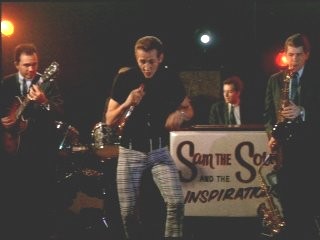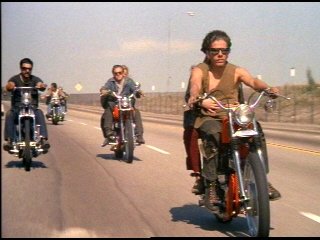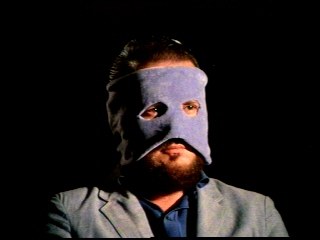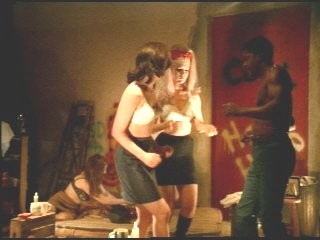
|
|
|
|
|
|
|
|
|
|
|
|
|
(1967) Director: Peter
Perry
Ah, the sixties. There have been a number of times when I wish that I was living in America during that era. Killer music from groups like Beatles to individuals like Jimi Hendrix, combined with rock concerts like Woodstock and Monterey... a feeling in the air to mellow out and not be stressed... hundreds of drive-ins everywhere playing quality schlock... plenty of free (and safe) love for the taking... cheap rents meaning you didn't have to work as hard to make a living... and MAD Magazine at its peak. Aside from little quibbles like the Vietnam war and the draft for it... a limited number of TV channels, all showing programming nowhere as edgy as that found today... more rampant racism... billy club-happy cops who wouldn't even think of reading you your rights... the cold war at its peak... frequent riots on and off campus... New York residents being stabbed while their neighbors do nothing about it... talk of violent revolution in the air... political assassinations... bikers using pool cues and other makeshift tools to beat up or kill people... and the popularity of the art of mime at its peak... it seems like it was the perfect era to live in. Of course, I was not being entirely serious in that
previous paragraph. If you think about it, practically every era has
its good points as well as bad. It's entirely possible that forty years
from now, the decade we are currently living in will have a nice
nostalgic glow to it, just like the sixties have for many people today.
I can only imagine what people in the forties (2040s, of course) might
find attractive about this era, maybe even stuff we hardly ever think
about now. They might even be Mondo Mod has no hesitation in immediately immersing us into the "here" and "now" of the culture it is covering, with the opening credits not only playing over various clips of what we are about to see (starting with, maybe prophetically, footage of a surfer experiencing a big wipeout), but what is apparently a "here" and "now" song, provided by the group The Gretschmen. I don't think the title song could have any other purpose, judging from these lyrics:
Then "strum-strum-strum" for what seems like an ungodly amount of time even compared to those three previous periods. Still, without having to concentrate on the vocals for a while, it does give us opportunity to focus on the written credits. Among other things, we learn this is a production from "Timely Motion Pictures, Inc.", that it stars, "The Youth Of The World", that we'll be seeing appearance by "Sam The Soul & The Inspirations" as well as "The Group" (which I personally think is as dumb a name for a rock band as "Yes".) Eventually, we get to hear the rest of the lyrics to the song:
By the way, as the credits draw to a close, they state that The Gretschmen are also credited with "additional music", which I assume are all those "strum-strum-strum" interludes above. The remaining credits also name the documentary's narrator, Humble Harve ("Los Angeles' #1 Radio Personality" - who later went to jail for manslaughter), who quickly starts talking once the credits and that awful song have ended. We are first shown footage of youths on the streets of Los Angeles, all of which comes across - and probably was - photographed in under fifteen minutes from the back of a pickup truck. "The film you are about to witness," Harve begins, "will no doubt be one of the most unforgettable experiences of your life! All scenes were completely unrehearsed and are presented just as the eye of the camera camera caught them! Whether you approve or disapprove, they are real! And they are happening now in the mod world all around you!" He continues: "The mod generation of the sixties is made
up of men and women 25 Next we are taken to Sunset Strip. "This is the place! This is where it's at! This is where it all happens! The new sound, the excitement! The pulsating fever that blocks out the humdrum existence!" So what is this, exactly? Well, we are given a taste of it when we are taken into one of these Sunset Strip clubs, where we get to see Sam The Soul & The Inspirations giving a live performance. How is the performance? Well, I'll put it this way: If Sam can get booked for a musical appearance at a club, then there is no reason it can't happen to me. You can't understand anything he is singing. Okay, okay, I am exaggerating; you can't understand about 80% of what he's singing - I was barely able to determine he was singing the classic "Betty Lou" ("She took the keys to my Cadillac car, etc.") Along with being clad in plaid pants and strutting on stage like a drunk businessman at the karaoke bar, it's perhaps not that much of a surprise that the cameraman spends much of the song sticking his lens up the miniskirts of the female youths dancing to (what could charitably be called) the beat of the band. Then we are taken to a renowned boutique of the area
which, according to Harve, is named "Belinda's", even though the sign
on the outside of the building is clearly lacking both an apostrophe
and an "s". The male owner of the establishment (curiously, not named
"Belinda") is interviewed, and tells us of the success the business has
had since starting from scratch six From Sunset Strip with its clubs and boutiques, where is the next logical place to go? You guessed it - motorcycle racing! Harve explains that with the import of cheap Japanese motorcycles in recent years, the mods have embraced this newly available form of transportation. We're told that 15% of motorcycle riders are women, though of all the women we see during this segment only one is actually piloting a motorcycle - the rest that are seen are women seated behind their boyfriends on the bikes, all curiously wearing bikinis despite it clearly being a very overcast day. We don't see any women when the documentary leaves this inner city dirt track and heads to the countryside for serious off-road racing (and where it's sunny.) For the next few minutes we are treated to a series of three second clips consisting of bikers racing from one side of the screen to the other. On Any Sunday, eat your heart out! Then we are shown what is reportedly the most popular sport among the mod generation, surfing. It is here that I must regretfully point out that the photography of Kovacs and Zsigmond, which up to this point has been pretty good considering they were apparently working with very little resources, falls short. All of a sudden the color is washed out and the footage seems to have been photographed with a camera that captures less details. It's as if the producers had decided to use stock footage from anonymous surfing documentaries for this segment. Not all of the documentary is a sunny look at the mod
generation. There's a pretty Obviously, Mondo Mod is far from being 100% accurate, and the passage of over 35 years has only increased the amount of hokey moments it has. So the real question is not if it's genuinely good, but if it is goofy enough to be considered prime camp. Well, not quite. Though many of the scenes that I have described may sound completely hilarious, much of them (particularly the sport sequences) go on for a long time past the point of welcome. Yet at the same time the document has some historical interest - not that it is necessarily an accurate time capsule of the time, but captures the spirit of the time. It captures techniques and attitudes that were considered "cool" for the audience at the time. For that reason, it may be worth a look. You certainly get your money's worth on the DVD; Something Weird Video once again puts a ton of extras on the disc, including a second movie (The Hippie Revolt), trailers, short subjects, audio commentary and more. I must admit that I found even more value for my money from this DVD, because I didn't pay for it. Thanks for the Christmas present, Mom! Check for availability on Amazon (DVD) See also: Dogtown & Z-Boys, Jabberwalk, Manson |
 doing
what many of us do now when we are nostalgic about a past era - watch a
movie that was made in that particular era. That's in fact what I did
recently when I had a feeling of nostalgia for the sixties, prescribing
myself the movie Mondo Mod for a cure. Not only was it
a movie made in the sixties, it was a movie about the
sixties. A documentary, it promised to take a look at what was hip and,
well, "mod" about the era, lensed by two now-acclaimed
cinematographers, Lazlo Kovacs and Vilmos Zsigmond (who later won an
Oscar for Close Encounters.)
doing
what many of us do now when we are nostalgic about a past era - watch a
movie that was made in that particular era. That's in fact what I did
recently when I had a feeling of nostalgia for the sixties, prescribing
myself the movie Mondo Mod for a cure. Not only was it
a movie made in the sixties, it was a movie about the
sixties. A documentary, it promised to take a look at what was hip and,
well, "mod" about the era, lensed by two now-acclaimed
cinematographers, Lazlo Kovacs and Vilmos Zsigmond (who later won an
Oscar for Close Encounters.) years old and under." (So did their parents have their own
mod generation when they were younger? And can even a seven year-old be
considered a "man" or a "woman"?) Further setting the scene, Harve
tells us some startling facts about these youths. "They're an
independent breed! And to adult eyes, this independence has made them
highly unpredictable! The mods aren't simply a 'new generation', they
are a new kind of generation!" How are they different? Well,
Harve lays it on us: "The youth of today spent eighteen billion dollars
in 1966. That's eighteen billion dollars!" He also tells us
that the "Youth Research Institute" (?) has forecast that by 1970 this
will rise to thirty billion dollars. "Today's youth see no
reason for putting off using their money. Their motto seems to be
'Spend it, man!'" Where does all this money go? Well, Harve tells
us that hairstyling is an important part of the mod scene. Your typical
mod male now avoids the $2.50 haircut in order to spend $25 for the
original styling and $7.50 or more to keep it styled. (As for how often
$7.50 must be plunked down, that strangely remains unanswered.) It's
also claimed your typical mod youth spends "8 to 10 dollars a month" on
records. "The mod set rules! And their number grows by leaps and
bounds daily!"
years old and under." (So did their parents have their own
mod generation when they were younger? And can even a seven year-old be
considered a "man" or a "woman"?) Further setting the scene, Harve
tells us some startling facts about these youths. "They're an
independent breed! And to adult eyes, this independence has made them
highly unpredictable! The mods aren't simply a 'new generation', they
are a new kind of generation!" How are they different? Well,
Harve lays it on us: "The youth of today spent eighteen billion dollars
in 1966. That's eighteen billion dollars!" He also tells us
that the "Youth Research Institute" (?) has forecast that by 1970 this
will rise to thirty billion dollars. "Today's youth see no
reason for putting off using their money. Their motto seems to be
'Spend it, man!'" Where does all this money go? Well, Harve tells
us that hairstyling is an important part of the mod scene. Your typical
mod male now avoids the $2.50 haircut in order to spend $25 for the
original styling and $7.50 or more to keep it styled. (As for how often
$7.50 must be plunked down, that strangely remains unanswered.) It's
also claimed your typical mod youth spends "8 to 10 dollars a month" on
records. "The mod set rules! And their number grows by leaps and
bounds daily!" months ago with just
eleven pieces (must have really marked up the prices.) Knowing that
this documentary was made "completely unrehearsed" and every scene was
presented "just as the eye of the camera caught them," this scene
proves especially valuable as a snapshot of just how people interacted
with each other during this era. As the owner of the store talks to the
camera, we learn that people often kept blinking and shuffling their
eyes around when talking. Another thing we learn is that people weren't
afraid of interfering with a documentary crew, which we see when a
female customer cuts in to talk to the store owner. This female
customer subsequently suggests that women of the time had no problem
changing in a dressing room that not only had a (thinly) beaded
curtain, but if that same relatively unblocked entrance happened to be
right in front of the store's big front window. It shouldn't come as a
surprise that this customer seems to have not only no problem with a
camera filming her changing her clothes through this beaded curtain,
but is equally accepting of the helpful store owner barging into the
changing room with no warning.
months ago with just
eleven pieces (must have really marked up the prices.) Knowing that
this documentary was made "completely unrehearsed" and every scene was
presented "just as the eye of the camera caught them," this scene
proves especially valuable as a snapshot of just how people interacted
with each other during this era. As the owner of the store talks to the
camera, we learn that people often kept blinking and shuffling their
eyes around when talking. Another thing we learn is that people weren't
afraid of interfering with a documentary crew, which we see when a
female customer cuts in to talk to the store owner. This female
customer subsequently suggests that women of the time had no problem
changing in a dressing room that not only had a (thinly) beaded
curtain, but if that same relatively unblocked entrance happened to be
right in front of the store's big front window. It shouldn't come as a
surprise that this customer seems to have not only no problem with a
camera filming her changing her clothes through this beaded curtain,
but is equally accepting of the helpful store owner barging into the
changing room with no warning. sober-minded
look at the clashes between the mods and the older generation,
including footage of the Sunset Strip protests against police
brutality. We also get the thoughts of Al Mitchell, a youth movement
leader despite his advanced age, who notes the gap between the
generations being the widest it's ever been. "There's going to have to
be some compromise, some meeting ground between the two generations
that exists," he stresses. But after that somewhat thoughtful segment
it's back to the same old thing. We get a segment of go-kart racing,
giving the movie a chance to show us go-karts, instead of
motorcycles, going from one side of the screen to another. We
visit the famous Whiskey A Go-Go club where we see youths dancing to
the beat of The Group, who believe it or not are even worse
than Sam The Soul & The Inspirations. There's later a hard-hitting
look at the biker culture that ends when the cameraman gets beaten up
by the bikers (curiously, Harve is silent during this part), an
interview with an L.S.D. user that's done over footage of a
"recreation" of one of this user's hallucinations (a woman dancing in
her underwear), a trip to a mod karate school, and lastly we are
plunged to the lowest part of the mod society - teens who gather
together in order to (gasp!) take off their shirts before dancing,
smoke pot with toilet paper roll bongs, and engage in interracial
romance!
sober-minded
look at the clashes between the mods and the older generation,
including footage of the Sunset Strip protests against police
brutality. We also get the thoughts of Al Mitchell, a youth movement
leader despite his advanced age, who notes the gap between the
generations being the widest it's ever been. "There's going to have to
be some compromise, some meeting ground between the two generations
that exists," he stresses. But after that somewhat thoughtful segment
it's back to the same old thing. We get a segment of go-kart racing,
giving the movie a chance to show us go-karts, instead of
motorcycles, going from one side of the screen to another. We
visit the famous Whiskey A Go-Go club where we see youths dancing to
the beat of The Group, who believe it or not are even worse
than Sam The Soul & The Inspirations. There's later a hard-hitting
look at the biker culture that ends when the cameraman gets beaten up
by the bikers (curiously, Harve is silent during this part), an
interview with an L.S.D. user that's done over footage of a
"recreation" of one of this user's hallucinations (a woman dancing in
her underwear), a trip to a mod karate school, and lastly we are
plunged to the lowest part of the mod society - teens who gather
together in order to (gasp!) take off their shirts before dancing,
smoke pot with toilet paper roll bongs, and engage in interracial
romance!